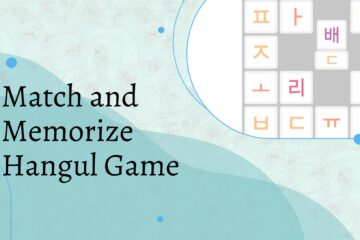Sometimes it’s hard not to feel stuck in a rut, especially if you are self-studying and don’t have a clear lesson plan to follow. Or maybe you feel tired of what you are currently doing. Trying out new methods to learn Korean is a good idea to revitalize your motivation! You can decide to pair a new technique alongside what you have already or swap entirely if it works for you.
Here are some new methods I have heard about, so let’s go through them and see if any could work for you. And don’t feel bad if some don’t work, everyone has their own learning style and limits on the time and effort they can put into learning!

Learn Vocab Using Keyword Method
To start this method is quite simple; you try to connect a word with a strong visual image using the sound of the word. The image or scene helps to connect the word much stronger in your brain along with the mnemonic.
An example could be “수박” which means watermelon and is pronounced as ‘subak’. So a keyword could be “Susan broke her Back trying to carry a Watermelon“.
Picking things you have emotional ties or memories with is great too, no need to go with a standard example. Pick something that works for you no matter how nonsensical!
It is a proven effective method but of course, can be very slow. Just think of trying to come up with something for each word! So this technique pairs well with other methods to learn Korean and works great if you want to save it for certain words you’d like to remember.
Shadowing and Copying Native Speakers
Shadowing is another one of the simple methods to learn Korean. Using any audio with a transcript (podcast, show, movie, YouTube, etc.) you speak along in Korean following the transcript/subtitles. Thats all! Not repeating it back, but saying it at the exact same time.
You can see how this can help with pronunciation and learning the flow of Korean phrases. As opposed to reading things out slowly from just a textbook, you can match when native speakers regularly shorten words or combine certain words and particles.
Along with reinforcing vocabulary and grammar structures. Since there are a lot of media with subtitles now think of how you can take advantage of this while pairing it with your regular study! Maybe after learning about past tense you find a YouTube video covering the topic and follow along going through sentences.
Of course, you have to be careful with this. Especially if you are studying on your own without feedback, you have to be wary of accidentally picking up bad pronunciation! If you mishear or don’t have a firm grasp on reading Korean out loud when following along it can trip you up and have you make more mistakes.

Rosetta Stone Method
One of the biggest methods to learn Korean or a lot of other languages focuses on learning without any translation. The basis is simple, how did you learn your native language? Your mom pointed at a ball and said “Ball” and that’s how you learned a lot of new vocabulary and sentences as you developed.
Simply enough apps, such as Rosetta Stone, will show you flashcards like other apps but with only Korean and a picture on it. You’ll go through the cards making a direct connection with the Korean word and thing in your mind. No middleman English! Rosetta Stone is a paid resource, with different plan options for individuals, corporate use, and schools. They regularly run discounts or have promotional codes to use.
The method is proven to work for sure, but again it can also be slow. The method helps to immerse you but without being fully immersed in your life outside you need more hours committed to learning. It can be nice to pair with something that will teach you grammar and structure, so you don’t have to wait to figure it out yourself.
Grow Past Beginner/Intermediate with an Only-Reading Method
On the opposite end of using pictures to help learn is only reading! You’ll need to have a good basis to start with this method; know Hangul, the most common 1,000 or so words, and basic Korean grammar.
A good pick for bookworms to try out! It’s said after around 90 novels you should know about 9000 of the most common words.
This reminds me of when I was a kid and read a lot, there were a lot of words I only knew and learned from books. Without looking up anything, I’d learn the meaning by the context and seeing it enough times to fully understand it. Though I would also regularly use a word and then think “Is that right? Does it mean what I think it means?” too haha so be cautious
Adapting this with other methods to learn Korean can be a fun one to get into and grow alongside your development. Start with children’s books, move into young adult books, and even on to full scholarly novels if you like! You’ll see and notice your progress in real time and have an easy way to show your level to others. Something like “I can read The Hunger Games in Korean!”

Learn Through Bidirectional Translation
Speaking of reading, this method takes reading to the next level. With bidirectional translation, you focus on using bilingual books or texts and compare the two translations!
It’s broken down into 3 steps:
- First, you read and understand the text, either with or without the original translation.
- Next, you translate the line into English yourself, this makes it more personal and similar to a review
- Finally, you translate it back into Korean, which acts to recall information, helping you lock it in better
By doing this process with increasing levels in Korean you can create a nice basis and get used to the most common words which repeat over and over. The creator has done a full talk on the technique discussing his experience with it and its benefits!
The Glossika Method
Created by a polyglot named Michael Campbell, this was specifically made for languages without many resources available. Luckily we don’t have to worry about that with Korean but the technique can still be useful and interesting to try out!
The method focuses solely on listening and speaking, repeating the sentences back in Korean. As you go along with different sentences increasing in level, you will develop an understanding and experience with Korean to build off of and learn.
This method isn’t as tested and proven, and the creator recommends it more for people who already have experience learning languages. So it isn’t a good pick for most beginners to try out, especially not if this is the only way you are studying Korean.
So now after giving you a couple of options try them out and see which one fits with you! Not every method will connect with everyone, so no need to hesitate to switch it up again when you need. Having variety is a good tactic to keep it fresh and not feel stuck in your study journey.



0 Comments